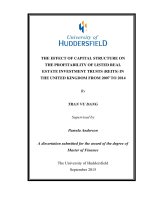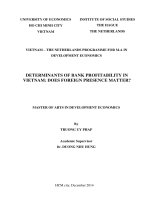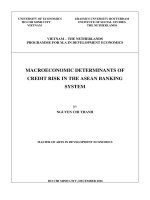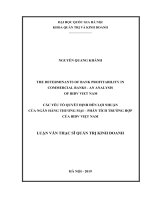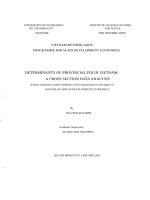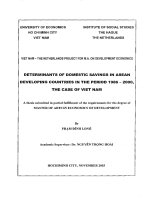DETERMINANTS OF FIRM PERFORMANCE OF VIETNAMESE LISTED REAL ESTATE COMPANIES: THE EVIDENCE OF LEVERAGE THRESHOLD
Bạn đang xem bản rút gọn của tài liệu. Xem và tải ngay bản đầy đủ của tài liệu tại đây (372.39 KB, 12 trang )
<span class='text_page_counter'>(1)</span><div class='page_container' data-page=1>
<b>DETERMINANTS OF FIRM PERFORMANCE OF VIETNAMESE LISTED </b>
<b>REAL ESTATE COMPANIES: </b>
<b>THE EVIDENCE OF LEVERAGE THRESHOLD </b>
THAI DUY TUNG, LY XUAN HAI, LAM THI KIEU MY
<i>Industrial University of Hochiminh City </i>
<i>, , </i>
<b>Abstract.</b> The aim of this paper is finding empirical evidences for the existence of factors that influence
firm performance of Vietnamese listed real estate companies. A single threshold panel regression analysis
is conducted to confirm threshold effect of leverage. Because of the leverage threshold effect, the impacts
of firm growth, firm size, and leverage on firm performance differ in the region below and above debt to
equity ratio at the level of 0.383. Performance of less levered firms are also less likely to statistically
response to the determinants while the empirical evidences of impacts can be found in companies that
pass the leverage threshold.
<b>Keywords. determinant, firm performance, panel data, real estate, threshold, Vietnam. </b>
<b>1 </b>
<b>INTRODUCTION </b>
In recent years, the economic growth of Vietnam has recovered in line with the upswing of the
global economy. Historical data from World Bank shows an uptrend of GDP growth rate of Vietnam from
the low level of 5.2 percent in 2012 to 6.8 percent in 2017. During that period, the GDP growth of the
world changed in the range of 2.5 percent in 2012 and 3.1 percent in 2017. Undoubtedly, Vietnam has
remained its outperformance of economic growth in the context of slow global recovery after the financial
crash in 2007-2008.
The economic recovery facilitated the demand of residential property, especially in major cities.
According to report of [21], urbanisation rate of Vietnam is 2.6 percent, the highest rate in ASEAN.
Strong residential demand could be seen in both the biggest cities, Hanoi and Hochiminh City. In
addition, the policy packages that support real estate market, such as direct funding, taxation, interest
rates etc…, have been implemented during this period as a result of the previous “frozen” session of the
real estate market.
The fact creates opportunities for real estate firms to enjoy phenomenal growth and profitability. In
an emerging market like Vietnam, real estate market makes remarkable impacts on the economy as a
whole. Since 2010, half of the top wealthiest Vietnamese are the owners of real estate companies, such as
Vin Group, FLC, Novaland etc …. It can be stated that this period is the “Golden Age” of the real estate
industry in Vietnam. Before this time, according to Hochiminh City Real Estate Association, the real
estate market has experienced a complete business cycle including growing, booming, slowing down,
recessing, recovering, and slowly growing stage during the last 20 years. The market enjoyed rapid
growth during the period between 2003 and 2006, before going into the crash in 2008 and the long
recession from 2011 to 2013. After 2013, Vietnamese real estate market recovered slowly and started to
soar since 2016. Each stage of real estate market often resulted in the co-movement of the stock market
and banking system, as well as capital flows. Undoubtedly, the temperature of real estate market in
Vietnam can affect macroeconomic activities through its impacts on urbanisation, infrastructure
development, fiscal policies, monetary policies, and even the legal system. Research on real estate
industry thus completes both the theoretical and empirical understandings of Vietnamese economy, a
rising and potential market to international stakeholders.
</div>
<span class='text_page_counter'>(2)</span><div class='page_container' data-page=2>
impacts on firm performance in real estate industry. Discovering the determinants of firm performance is
thus a challenge to Vietnamese real estate companies in order to survive in such highly competitive
market.
The determinant of firm performance is a popular topic in the study of finance. However, the firm
performance of Vietnamese real estate listed companies has not been fully researched so far. The studies
of [3], [19] or [1] have found some empirical evidences of the determinants on Vietnamese real-estate
firm performance but the disagreement on the impacts and signs of the relationship has existed. The
inconsistency in results of previous studies infers changing behaviours of factors, or perhaps the
relationship might not be linear. There could be a likelihood of “break” over a threshold through which
the correspondence of firm performance to its determinants would change. That reasoning suggested the
authors to conduct this study.
This research aims at developing the empirical evidences of the topics by employing threshold panel
regression. If the threshold effect is confirmed, this paper will contribute valuable findings for a more
comprehensive analysis and discussion on endogenous and exogenous factors that affect firm
performance of Vietnamese real-estate listed companies. Consequently, more detailed implications for
policies at firm level can be made to achieve better performance in real estate industry in Vietnam.
<b>2 </b> <b>LITERATURE REVIEW </b>
<b>2.1. Real estate industry in Vietnam </b>
Laws and regulations in most countries commonly consider real estate lands and properties on those
lands. According to Vietnamese law, in particular the Civil Law 2005, real estate includes land,
construction on land, and other assets as integral parts of that land that regulated by the law. Real estate is
either a special asset class, a research topic or a business.
<i>[14] categorized real estates in Vietnam into the following groups: 1) Residential houses are either </i>
single houses, apartments or land area on which single houses or apartment buildings are constructed, 2)
<i>Commercial real estates are offices for rent, shopping malls, markets, stores, hotels, restaurants, resorts </i>
<i>and available lands on which such buildings are constructed , 3) Industrial real estates are plants, </i>
<i>warehouses, facilitating buildings, mines and lands related to mentioned constructions, 4) Agricultural, </i>
<i>Forestry, and Fishery real estates are forests, aquacultural areas, farms, and drainage systems, 5) Public </i>
<i>real estates are the State owned offices, public hospitals, parks roads, schools and other </i>
<i>community-beneficial buildings, and 6) Alternative real estates are the ones that cannot be classified into the </i>
mentioned groups, such as religious buildings, charity centres etc…
Real estate companies in Vietnam mainly have business in residential houses and commercial real
estates whose growth is facilitated by population growth, increasing urbanisation rate and extending
consumption of the growing middle class. Most of them are real estate developers which acquire potential
land and develop residential and commercial projects. Seeking profits on procyclical basis, Vietnamese
real estate companies depend much on economic cycles and money supply. However, the increasing
urbanisation rate and population help maintaining a stable demand growth in the real estate market. The
concern of real estate companies thus perhaps lie in the firm performance in different cycles.
<b>2.2. Theoretical foundation of firm performance and its determinants </b>
<i><b>Firm performance </b></i>
</div>
<span class='text_page_counter'>(3)</span><div class='page_container' data-page=3>
According to [16], firm performance can be measured in both financial and organisational
perspective. As for financial aspect, the Return on Asset (ROA) and Return on Equity (ROE) are often the
proxies for firm performance. In more advanced stock markets, the firm performance can be observed by
market ratio, such as the Price to Earnings ratio, Market to Book ratio, or Tobin’Q. As for organisational
aspect, firm performance can be assessed by evaluating factors such as: managerial efficiency, social
efficiency, overall efficiency of all corporate functions including sales, marketing, customer service etc.
Under the research context that limits within the group of listed real estate companies in Vietnam
stock market, the most appropriate measurement of firm performance should be the financial performance
which is analysed by ROA and ROE, rather than the other ratios. Vietnam stock market is still in frontier
or emerging market; therefore, it may be informationally inefficient and the market price is not likely to
reflect the adequate firm performance.
<i><b>Determinants of firm performance </b></i>
Determinants of firm performance consist of 2 groups: endogenous factors and exogenous factors.
Endogenous factors are the factors that can be controlled to a specific extent within the firm and
employed to enhance the performance by corporate policies. The study of endogenous factors therefore
fully meet the objectives of this papers, that is, exploring decisive factors of firm performance and
suggesting policy implications that may be applicable in Vietnamese listed real estate companies. On the
other hand, exogenous factors cannot be influenced by policies at corporate level. These factors thus may
not contribute to implications for corporate policies. However, they should be considered to give a more
comprehensive analysis of firm performance.
The endogenous group considered by the authors includes firm size, leverage, growth and age.
<i>Firm size can be determined by total assets, net revenue or the number of employees [12]. The </i>
economies of scale infers that average expense per unit diminish along with the increase of quantity.
Accordingly, return per unit and quantity have positive relationship. Economies of scale can be achieved
by the decline of fixed cost, the increase of expertisation and the efficiency of purchase on large amounts.
In addition, large-size firms possess more competitive features, such as reputation, brand identification,
market share or financial strength. They also have greater access to low-cost finance. For those reasons,
firm size has positive impact on profit and firm performance.
<i>Leverage is often measured by the ratio of Debt on Equity or Debt on Total Asset. It shows the </i>
corporate capital structure and relative level of Debt on other sources of capital. [15] stated that capital
structure and firm value were relevant in case of corporate tax. The aim of debt usage is taking advantage
of fixed interest expense to increase residual income of equityholders. Because interest expense is tax
deductible, the use of debt also creates benefit from interest tax shield and generates more after-tax cash
flows. The firm value thus increases in line with the use of debt. Nevertheless, the increasing leverage
also results in additional financial risk. Initially, low cost of debt and tax-shield benefit make the average
cost of capital decrease if using more debt. When the capital structure achieves the “optimal” point,
additional debt raises the cost of debt because of higher default risk. Therefore, [20] believed that highly
levered firms would be more vulnerable and exposed to more risks in depression cycle.
<i>Growth is another factor of firm performance. [9] concluded that firms with stable growth would be </i>
more efficient and survive, while smaller and less efficient firms experienced more variate growth rates,
signalling more possibility of decline and failure. Recent positive growth rate, confirmed by [4],
anticipated better firm performance.
<i>Firm age is the number of years during which the firm exist in the industry. [4] found that most </i>
industrial exits happened in case of young firms, and large young firms survived longer than smaller ones.
The companies with longer years of experience also accumulated more capital to finance their business.
Their long-term network would play an important role in the competition. Thus, there would be a positive
relationship between age and profit or firm performance.
</div>
<span class='text_page_counter'>(4)</span><div class='page_container' data-page=4>
income, technology, the level of development in infrastructure, competition, and bargain power of
customers and suppliers. In the scope of this research, the authors analyse the impact of economic factors
on firm performance, in particular, the GDP growth rate which is observable and has direct impacts on
many other macroeconomic factors, such as national income, capital flows, money supply, interest rate
policy, and inflation. Therefore, GDP growth is expected to have coherently positive correlation with firm
performance.
<b>2.2. Previous studies on determinants of firm performance in Vietnamese real estate companies </b>
International empirical evidences of determinants of firm performance can be found in numerous
previous studies.
[12] used ROA and ROE as proxies for firm performance of Greek companies. Their research
confirmed the correlation of leverage, export activity, location, firm size, and efficient management with
firm performance. Accordingly, Greek firms with great performance seem to be large, young, exporting
firms with efficient management team. Furthermore, they would have optimal leverage and sufficient
liquidity.
[24], testing on the sample of 167 Jordanian companies in the period between 1989 and 2003, found
leverage, asset growth, firm size, corporate tax and industrial features as determinants of firm
performance which was measured by ROA. Their study concluded a negative relationship between firm
performance and capital structure, implying the overleverage of the sampled companies during the period
under the study.
The negative impact of debt level on firm performance was also detected in the research of [18].
Based on the sample of 30 non-financial firms in Nigeria, the authors found the evidence of positive
impacts of age and size on ROE. Also, ROE did well as the proxy for firm performance in companies of
beverage and construction industry, while the model with ROA as dependent variable explained better in
case of chemistry and printing industry. Undoubtedly, the use of ROE and ROA as the measurement for
firm performance might not result in the same conclusion.
[20] and [10] found evidences of positive relationship of growth rate and ROA. The research of [20]
agreed with some previous studies on the fact that leverage negatively affected firm performance. [17] did
not find any statistical significance of age’s impact on ROA of Kenyan insurance companies, while the
influences of capital structure and size on profitability were revealed.
In Vietnam, researches on firm performance of listed companies have been conducted by [3], [19]
and [1]. The study of [3], employing ROA as the proxy of firm performance, discovered that construction
companies which were too credit intensive would be less profitable. However, [3] did not find the
statistical evidences of impacts made by asset growth and firm size on firm performance. Papers of [19]
and [1] derived the same conclusion regarding to negative impact of leverage on firm performance.
Nonetheless, the two papers distincted in the other explainable variables. While variables of endogenous
factors such as asset structure, treasury stocks, and firm age were mainly used in the study of [19] who
also found inconsistent empirical results in case of different dependent variables – ROE and ROA – in
their models, [1] employed GDP growth rate as the proxy for exogenous factors and confirmed positive
influences of GDP growth and firm size on firm performance measured by ROA.
The distinctive empirical results in different research contexts and periods imply the inconsistent
impacts of stated determinants on firm performance. The variation of impacts can be explained by the fact
that economic relationships would change at some certain points which we call “threshold”. In fact, most
relationships will not be the same in long term, and a non-linear model is more likely to explain such
correlations. [5] proposed an approach which estimated the effect of threshold on non-dynamic panels. [2]
used this method to determine a triple-threshold effect and inverted-U shaped relationship between capital
structure and firm value in China. Research of [13] also proved the non-linear impact of debt ratio on firm
value in Taiwan, inferring estimation for optimal capital structure. Evidence for the optimal R&D
expense to maximise firm performance in Taiwanese listed information technology and electronic
companies was found by [23].
</div>
<span class='text_page_counter'>(5)</span><div class='page_container' data-page=5>
<i>Table 1. Summary of the previous studies on determinants of firm performance </i>
Role of variable Variable name Studied by <sub>(empirical result) </sub>Sign of impact
Dependent variable ROA
(Return on Asset)
[1], [3], [10], [12]
[17], [18], [19], [20] [24]
Dependent variable ROE
(Return on Equity) [12], [18], [19]
Independent variable Firm Size
[1], [18], [20], [24]
[3]
[10]
+
Insignificant
-
Independent variable Leverage
[12]
[1], [3], [17], [18], [19], [20],
[24]
+
-
-
Independent variable Firm Growth [1], [10], [18], [19], [20], [24]
[3]
+
Insignificant
Independent variable Firm Age [18], [19]
[17]
+
Insignificant
Independent variable GDP growth [1] +
Threshold variable Debt ratio [2], [13]
Threshold variable R&D intensity [23]
<i>Source: summarized by the authors </i>
<b>3 </b>
<b>RESEARCH METHODOLOGY </b>
<b>3.1 Research models </b>
<i><b>Panel regression model without threshold </b></i>
Aiming at discovering the determinants of firm performance in Vietnamese listed real estate
companies, we develop our research models on the basis of findings by [12], [24], [20], [3], [18], [19],
[10], [17], and [1]. Accordingly, firm performance is affected by firm growth, leverage, firm size, firm
age, and GDP growth. Most previous studies used ROA as the proxy for firm performance, and we also
share the same opinion because ROE is more distorted by financial policy of each firm.
The initial research model which is called Model 1 is illustrated in the Equation (1)
<sub> </sub> <sub> </sub> <sub> </sub> <sub> </sub> <sub> </sub> <sub> </sub><b> (1) </b>
Where: i: indicate the company in panel
t: indicate the time in panel
<i>Dependent variable: </i>
<sub> </sub>: Return on Asset
<i>Independent variable: </i>
<sub> </sub>: firm growth
: firm size
<sub> </sub>: leverage
<sub> </sub>: firm age
: GDP growth of Vietnam
<i><b>Panel regression model with threshold </b></i>
</div>
<span class='text_page_counter'>(6)</span><div class='page_container' data-page=6>
threshold effect on the impacts of leverage, firm age, size and firm growth. The single threshold creates
two distinctive regions (or category), one below and one above the threshold, and these variables are
considered region-varying. Leverage is both the independent variable and the threshold variable in this
paper. The selection of threshold variable derived from the fact that Vietnamese real estate companies are
relatively debt intensive. On average, debt to equity ratio is 1.6 (see Table 3), or nearly two thirds of
company’s capital financed by debt. The significant debt dependence may result in the variation of
impacts caused by other determinants.
We have Model 2 in the Equation (2).
<sub> </sub> { <sub> </sub> <sub> </sub>
(2)
Where: is the co-efficient of region-invarying variable
is the threshold of leverage
<b>3.2. Research hypotheses </b>
<i><b>Impact of Firm Growth on firm performance </b></i>
Firm with high and stable growth rate is expected to be more profitable. [9] and [4] argued that
high-growth firm would survive in the competition and generate more potential cash flows. In addition,
high-growth companies are often highly appreciated by growth investors whose buying pressure will raise
the stock price. It also makes the lenders more optimistic. Consequently, companies with higher growth
rate may be more accessible to finance for potential investment projects. [24], [20], [18], [19], and [1]
found the positive impact of firm growth on firm performance. The hypothesis is:
<i>H1: Firm Growth has positive impact on ROA </i>
<i><b>Impact of Leverage on firm performance </b></i>
Most previous studies, except [12], found the negative relationship between leverage and ROA (see
Table 1). Although the use of debt, according to [15], create additional cash flows in the form of tax
shield, the rising default risk will soon raise the cost of debt, thus offsetting the advantage of interest tax
shield. The development of financial markets has facilitated debt use, resulting in overleverage in most
countries. The empirical results, thus, supported the following hypothesis:
<i>H2: leverage has negative impact on ROA. </i>
<i><b>Impact of Firm Size on firm performance </b></i>
As being discussed in Section 2, firm size is expected to have positive correlation with profit and
firm performance because of the economies of scale, competitive advantages, and access to finance. In
this paper, firm size is measured by the natural logarithm of total asset instead of the actual figures. The
use of natural logarithm of total asset will reduce the potential of outliers in the research model.
<i>H3: Firm size has positive impact on ROA </i>
<i><b>Impact of Firm Age on firm performance </b></i>
The age of firm, calculated by subtracting the year of establishment from current year, reflects the
level of capital accumulation and business experience. Long history also provides more information
which facilitates financing decision of external investors. Therefore, firm age and ROA will have positive
relationship, as confirmed by the empirical studies of [18] and [19].
<i>H4: Firm age has positive impact on ROA </i>
<i><b>Impact of GDP growth on firm performance </b></i>
GDP growth represents macroeconomic variables in the model. In case of procyclical industries such
as real estate, the relationship of firm performance and macroeconomic conditions is even closer. In
Vietnam, [1] found statistically significant result for that impact in the case of real estate industry.
<i>H5: GDP growth rate has positive impact on ROA. </i>
</div>
<span class='text_page_counter'>(7)</span><div class='page_container' data-page=7>
<i>Table 2. Summary of the variables in the research models </i>
Role of variable Variable name Formula
Expected sign
of the
relationship
Source
Dependent variable ROA
(Return on Asset)
Financial
Statements
Independent variable Firm Size Natural logarithm of Total
Asset +
Financial
Statements
Independent variable Leverage
-
Financial
Statements
Independent variable Firm Growth
+
Financial
Statements
Independent variable Firm Age Current year – establishing year + Financial
Statements
Independent variable GDP growth
+
Data of
World Bank
<i>Source: summarized by the authors</i>
<b>4 </b>
<b>DATA HANDLING </b>
<b>4.1. Data description </b>
The data is collected from audited financial statements of 54 real estate companies listed in
Vietnamese stock market. The period under the study ranges from 2010 to 2017, when Vietnamese
economy experienced the recession after the financial crisis 2007-2008 and the recovery since then.
Descriptive statistics table is shown in Table 3.
<i>Table 3. Descriptive statistics</i>
Variable Obs Mean Std. Dev. 25th percentile 50th percentile 75th percentile
ROA 432 0.026 0.071 0.004 0.022 0.053
SIZE 432 14.213 1.255 13.222 14.077 15.159
AGE 432 14.222 6.848 9 13 18
GROWTH 432 0.660 2.742 -0.291 0.064 0.628
LEV 432 1.600 1.547 0.659 1.196 2.012
GDP 8 0.061 0.005 0.057 0.062 0.065
<i>Source: calculated by the authors</i>
Average ROA of Vietnamese real estate companies in the period 2010-2017 is 2.6 percent, while the
standard deviation is 7.1 percent, reflecting the risky nature of real estate industry. Low standard
deviation of SIZE implies that the companies in the sample are relatively comparable. The statistics for
GROWTH is affected by extreme value because of the variance in business cycle of each firm. However,
the positive and negative outliers have offsetted each other, the mean of GROWTH in overall may not be
too distorted. Negative growth existed mainly in the period between 2011 and 2013 when the real estate
market decreased as the result of post-crisis recession. Mean of LEV is 1.6, representing the average debt
to equity ratio of Vietnamese real estate industry. The value of minimum and maximum value as well as
number of observation is showed in Table 3.
<b>4.2. Unit root tests for panel </b>
</div>
<span class='text_page_counter'>(8)</span><div class='page_container' data-page=8>
The null hypothesis [6] is that panels contain unit roots, while the alternative hypothesis support the
fact that panels are stationary. Result of unit root test according to [6] is illustrated in Table 4.
<i><b>Table 4. Summary of Unit root test </b></i>
Variable Statistic Z p-value Stationarity
ROA -0.0095 -14.9071 0.0000 Yes
SIZE 0.8741 4.5737 1.0000 No
AGE 1.0000 7.3485 1.0000 No
GROWTH -0.2282 -19.7276 0.0000 Yes
LEV 0.1384 -11.6463 0.0000 Yes
GDP 0.3977 -5.9299 0.0000 Yes
<i>Source: calculated by the authors</i>
Unit root tests on original series conclude that SIZE and AGE are non-stationary, suggesting that the
regression using these two variables may be not reliable. One of common approaches to handle this
problem is replacing the original series by their differentials. However, the differentials of AGE are 1 in
every year because of its calculation. Therefore, the meaning of estimated co-efficient for AGE should
not be considered. As for variable SIZE, its first differential series is stationary although the use of the
first differential reduces the number of observations by the number of firms in the sample.
<b>4.3. Correlation matrix among variables </b>
In order to strengthen the prediction of relationship among variables, an analysis of correlation
matrix was conducted in Table 5.
<i>Table 5. Correlation matrix </i>
ROA GDP DSIZE LEV GROWTH
ROA 1.000
GDP 0.056 1.000
DSIZE 0.416 0.129 1.000
LEV (0.170) 0.010 0.001 1.000
GROWTH (0.224) 0.069 (0.172) 0.004 1.000
<i>Source: calculated by the authors</i>
Correlation matrix in Table 5 shows relatively weak correlation among explanatory variables and
strong correlation between the groups of explanatory variables and the dependent variable. Firm size
measured by the first differential of SIZE has strong positive relationship with firm performance. On the
other hand, the correlation between leverage and firm performance may be on the opposite side. GDP
growth may have positve impact on firm performance, as being tested in the previous studies, despite the
weak correlation shown in the sample. The most unexpected outcome of the correlation analysis is the
strong negative relationship between sale growth and performance although the previous studies mostly
gave the opposite empirical evidences. Further analysis employing panel regression with threshold in the
following section will reveal partly this unexpectation.
<b>5 </b>
<b>RESULT AND DISCUSSION </b>
<b>5.1. Results of panel regression model </b>
Panel regression model is estimated in 3 approaches: Pooled OLS, Fixed Effect Model (FEM) and
Random Effect Model (REM). The summary of estimation result is displayed in Table 6.
</div>
<span class='text_page_counter'>(9)</span><div class='page_container' data-page=9>
hypothesis of Hausman test cannot be rejected. In this situation, both FEM and REM estimations are
robust, but REM is more efficient because it is estimated by General Least Square method.
<i>Table 6. Summary of Model 1</i>
Pooled OLS FEM REM
GDP 0.2433952 0.2777343 0.2639976
( 0.682) (0.594) (0.613)
D1.SIZE 0.1213384*** 0.1105276*** 0.1144005***
(0.000) (0.000) (0.000)
GROWTH -0.0001058*** -0.0000805*** -0.0000897***
(0.001) (0.006) (0.002)
LEV -0.0073518*** -0.0110178*** -0.0091382***
(0.0000) (0.0000) (0.0000)
R-square 0.2263 0.2161 0.2235
F-statistic 27.27 23.94
(0.0000) (0.0000)
(*), (**), (***) indicates that the estimated co-efficients are statistical significant at 10%, 5%, 1%, respectively. Numbers in
brackets are p-values. REM does not follow F-distribution, but Chi-square distribution instead.
<i>Source: calculated by the authors</i>
<b>5.2. Result of panel regression model with threshold </b>
The empirical result in Section 5.1 can be enhanced by threshold regression. The threshold variable
used in this research is LEV, the debt to equity ratio. We follow the idea of optimal capital structure
proposed by [16]. The leverage threshold effect on ROA was discovered and confirmed in papers of [2]
and [13]. However, leverage threshold of firm performance in Vietnamese real estate industry has not
studied so far.
Threshold effect is tested by the approach of [5] who proposed bootstrap procedure to estimate the
co-efficients of region-varying variables. GDP is the only variable which we consider region-invarying.
In the other words, impact of GDP on firm performance is less dependent on leverage threshold effect.
<i>Table 7. Result of threshold effect test and threshold estimator </i>
Model Threshold Lower Upper
Single threshold 0.383 0.3733 0.386
Threshold RSS MSE Fstat Prob Crit10 Crit5 Crit1
Single 0.799 0.0022 64.64 0.022 31.2081 42.9117 79.7314
<i>Source: calculated by the authors</i>
Table 7 illustrates the result of threshold estimation using 1000 times of bootstrap. The single
threshold for leverage is 0.383 which divide the impact of region-varying variables into two categories.
The Table 8 shows the summary of Model 2, the panel regression with threshold. The estimated
results take into account of the correction for heteroskedasticity. The standard errors, therefore, were
recalculated to be robusted. As for the problems with multicolinearity and serial correlation, the related
diagnosing tests did not find the statistical evidences for their existence at 5% of significant level.
</div>
<span class='text_page_counter'>(10)</span><div class='page_container' data-page=10>
debt to equity ratio higher than 0.383. However, the firm growth shows a negative correlation with ROA
in the group of highly levered companies.
<i>Table 8. Summary of Model 2 </i>
Robust
Roa Coef. Std. Err. t P>t [95% Conf. Interval]
Gdp 0.8646406** 0.4110342 2.1 0.04 0.0402103 1.689071
_cat#c.lev
0 -0.2624826 0.1653572 -1.59 0.118 -0.594147 0.0691819
1 -0.0116778** 0.004509 -2.59 0.012 -0.0207217 -0.0026339
_cat#c.growth
0 0.007038 0.0047948 1.47 0.148 -0.0025791 0.016655
1 -0.0000998*** 6.32E-06 -15.79 0.000 -0.0001125 -0.0000871
_cat#cD1.size
0 0.282387 0.1561138 1.81 0.076 -0.0307376 0.5955116
1 0.0629122*** 0.0145162 4.33 0.000 0.0337964 0.0920279
_cons -0.016578 0.0270244 -0.61 0.542 -0.0707821 0.0376261
(*), (**), (***) indicates that the estimated co-efficients are statistical significant at 10%, 5%, 1%, respectively. Category 0
represents the region in which leverage is equal or less than 0.383. Category 1 represents the region in which leverage is greater
than 0.383
<i>Source: calculated by the authors </i>
<b>5.3. Discussion </b>
Debt financing is a crucial source of capital, especially in the case of Vietnamese real estate industry.
The expansionary monetary policy and preferential credit packages for real estate investment in recent
years have encouraged the use of additional debt in real estate companies as well as the rapid growth of
real estate market. Overleverage becomes common in this industry and changes the impacts of the
determinants on firm performance.
The fact that there would be no significant impact of firm growth, size and leverage on performance
of less levered companies may improve conclusions derived from the previous studies on this topic. The
leverage threshold is far lower than the average debt ratio of the sample, i.e. 1.6, inferring that the
observations in Category 0 are the minority in the sample. It is possible that performance of real estate
companies with no or little debt compared to the norms seems to be unpredictable with the use of growth,
leverage or firm size. On the other hand, firm performance of greater-than-0.383 debt ratio would show a
more “visual” behaviour.
The negative sign of LEV’s co-efficient is the statistical evidence for our hypothesis. When debt
ratio exceeds 0.383, the additional debt may reduce firm performance. The finding agrees with statements
of most previous studies, except [12]. However, the inversed conclusion which argues for positive impact
of leverage in less levered companies cannot be confirmed. The management team should not use
leverage to increase firm performance for that reason.
Although most previous studies found the positive co-movement of revenue growth rate and firm
performance, this study did not empirical evidence for that relationship. In case of low level of debt, the
significance of growth is rejected. At high level of debt, real estate companies are faced to more pressure
of generating cash flows to repay the debt. The management therefore pays more attention to sales target
at the expense of profit because real estate is a special product whose liquidity may not be consistent. In
this situation, the growth is low quality and harmful to firm performance.
</div>
<span class='text_page_counter'>(11)</span><div class='page_container' data-page=11>
thus hold huge advantages in competition and connection with major banks. In recent years, the trend of
M&A in Vietnamese real estate companies can be justified by this argument.
The threshold model also rejects the insignificance of GDP growth which the Model 1 could not do
the same. The impact of GDP growth is once again confirmed, strengthening the empirical evidence of
[1].
<b>6 </b>
<b>CONCLUSION </b>
This paper has extended empirical results of previous studies on the determinants of firm
performance in Vietnamese listed real estate companies. We found the evidence of leverage threshold
which affects the influence of firm growth, firm size and leverage itself on firm performance measured by
the return on asset. Therefore, the impacts of those determinants are partly significant. Below the leverage
threshold, most determinants except firm size are proved to have no significant influence on firm
performance. The expected relationships are able to be found in the region above the threshold.
The fragmented impacts suggest researchers and managers to be more prudential when considering
policies that enhance the firm performance. In a changing world, the non-linear approach would be more
applicable to analyse economic relationships.
As for further researches, more advanced threshold variables should be studied and tested for their
statistical significance. The time variable can be employed to evidence the structural break of
time-varying economic links, while lagged variables will be more meaningful for forecasting purposes.
<b>REFERENCE </b>
[1] Bui, N. T. (2016). Impacts of Working Capital Policy on Return on Asset of Vietnamese Real Estate
<i>Companies. Journal of Can Tho University, 2016, 18-27. </i>
[2] Cheng, Y. S., Liu, Y. P., & Chien, C. Y. (2010). Capital structure and firm value in China: A panel threshold
<i>regression analysis. African Journal of Business Management, 4(12), 2500-2507. </i>
[3] Do, D. T. N. (2011). Financial Factors of Firm Performance in Construction Companies Listed in Vietnamese
Stock Market. (Master dissertation, University of Economics of Hochiminh City, Vietnam)
<i>[4] Frank, M. Z. (1988). An intertemporal model of industrial exit. The Quarterly Journal of Economics, 103(2), </i>
333-344.
<i>[5] Hansen, B. E. (1999). Threshold effects in non-dynamic panels: Estimation, testing, and inference. Journal of </i>
<i>econometrics, 93(2), 345-368. </i>
[6] Harris, R. D., & Tzavalis, E. (1999). Inference for unit roots in dynamic panels where the time dimension is
<i>fixed. Journal of econometrics, 91(2), 201-226. </i>
<i>[7] Hausman, J. A. (1978). Specification tests in econometrics. Econometrica: Journal of the econometric society, </i>
1251-1271.
<i>[8] Im, K. S., Pesaran, M. H., & Shin, Y. (2003). Testing for unit roots in heterogeneous panels. Journal of </i>
<i>econometrics, 115(1), 53-74. </i>
<i>[9] Jovanovic, B. (1982). Selection and the Evolution of Industry. Econometrica: Journal of the Econometric </i>
<i>Society, 649-670. </i>
</div>
<span class='text_page_counter'>(12)</span><div class='page_container' data-page=12>
[11] Levin, A., Lin, C. F., & Chu, C. S. J. (2002). Unit root tests in panel data: asymptotic and finite-sample
<i>properties. Journal of econometrics, 108(1), 1-24. </i>
<i>[12] Liargovas, P. G., & Skandalis, K. S. (2010). Factors affecting firms’ performance: The case of Greece. Global </i>
<i>Business and Management Research: An International Journal, 2(2), 184-197. </i>
[13] Lin, F. L., & Chang, T. (2011). Does debt affect firm value in Taiwan? A panel threshold regression analysis.
<i>Applied Economics, 43(1), 117-128. </i>
<i>[14] Ly, X.H (2017). Determinants of firm performance of Vietnamese listed real estate companies.( Master </i>
dissertation, University of Finance and Marketing, Vietnam)
<i>[15] Modigliani, F., & Miller, M. H. (1963). Corporate income taxes and the cost of capital: a correction. The </i>
<i>American economic review, 53(3), 433-443. </i>
[16] Murphy, G. B., Trailer, J. W., & Hill, R. C. (1996). Measuring performance in entrepreneurship research.
<i>Journal of business research, 36(1), 15-23. </i>
[17] Mwangi, M., & Murigu, J. W. (2015). The determinants of financial performance in general insurance
<i>companies in Kenya. European Scientific Journal, ESJ, 11(1). </i>
[18] Onaolapo, A. A., & Kajola, S. O. (2010). Capital Structure and Firm Performance: evidence from Nigeria.
<i>European Journal of Economics, Finance and Administrative Sciences, 25, 70-82. </i>
[19] Quan, M. N, & Ly, T. P. T (2014). Analyzing Factors Affecting Firm Performance of Real Estate Companies
<i>Listed on Vietnamese Stock Market. Journal of Can Tho University, 33, 65-71. </i>
<i>[20] Safarova, Y. (2010). Factors that determine firm performance of New Zealand listed companies (Doctoral </i>
dissertation, Auckland University of Technology).
<i>[21] Savills (2018). Vietnam Residential: Where to from here? Available at: </i>
a/asia-pacific-research/vietnam-research/spotlight/vietnam-residential-20181127-en.pdf
[22] World Bank (2019). Open data by indicator. Available at:
[23] Yeh, M. L., Chu, H. P., Sher, P. J., & Chiu, Y. C. (2010). R&D intensity, firm performance and the
<i>identification of the threshold: fresh evidence from the panel threshold regression model. Applied economics, </i>
42(3), 389-401.
<i>[24] Zeitun, R., & Tian, G. G. (2007). Capital Structure and Firm Performance: Evidence from Jordan. Australia </i>
<i>Accounting Business and Finance Journal, 1(4), 148-168.. </i>
</div>
<!--links-->
